This post was written by Marcus Tennant, principal systems architect at Yokogawa.
Getting out the cake and candles may have been overdoing it, but ISA-88’s 20th birthday was 28 February 2015. Since 1995, it has served countless manufacturers, primarily in batch process industries, while growing and evolving to cover new areas, and even spawning other standards. The first batch control standard in the ISA-88 series was approved by the American National Standards Institute (ANSI) in that year, and one could argue that the ISA95 standards on enterprise hierarchy and ISA-106 on applying procedural and equipment models to continuous processes came out of concepts in ISA-88.

Testimonials by operating companies best represent the benefits of the ISA-88 series of standards over the years. Some benefits attributed to the standard are:
- quicker time to market as a result of reduced effort required to build plants
- ability to create recipes and equipment logic in parallel
- lower total cost of ownership for automation
- reduced training costs as engineers move between plants and process cells with different suppliers’ systems and processes
Its importance continues to increase as a guide for all manufacturers, but particularly in the chemical and oil and gas industries. These and related industries are enjoying a resurgence in North America. New sources of oil and gas make the landscape far more attractive for plant upgrades and greenfield construction throughout the hydrocarbon value chain—from upstream extraction, pipelines, and refining to bulk and specialty chemicals. In some respects, the success of this resurgence is its own greatest threat, as demand is growing rapidly for skilled engineering and construction workers. Some recent studies predict human resource shortages will impose a severe constraint in the future.
Access to cheap oil- and natural gas-based feedstocks supports growth, but keeping manufacturing sustainable in the long term depends on a variety of considerations, which is where concepts from ISA-88 fit into the picture.
Reducing life-cycle costs
Competition among global manufacturers requires low costs for all factors of production:
- plant construction
- engineering
- maintenance
- material use
- personnel
- energy
Naturally, automation is a major part of the equation. Effective control systems combined with optimal work practices support operational excellence. Due to its wide adoption, ISA-88 has had a leading role in how batch control systems are designed and implemented. ISA-88’s recipe structure, the separation of product and process information, and the encouragement of design modularity have influenced most batch processes in this country, if not the world, over the past 20 years. Modularization in process industries is getting a new look in facilities, processes, and automation—and ISA-88’s contributions are helping support this movement.
Start with modular construction
In years past, most plant construction was stick-built on site with carpenters, fabricators, pipe fitters, and electricians building equipment from scratch to match designs. They welded together tank sides, cut and connected piping, and added wiring and control cabinets. Small armies of skilled tradesmen and technicians had to be brought to the site for months at a time. Working conditions were not always ideal and were subject to weather interference. Even minor safety incidents were an issue, particularly as they could affect a plant’s insurance rates.
Costs and labor constraints are changing the picture. Plant owners have to keep costs under control and work around skilled labor shortages, and one way to do this is by undertaking major construction projects without armies of people on site. Such constraints push companies to be more creative and do more with fewer resources. One option, which is growing in popularity, is building more of the plant equipment as modules in specialized facilities rather than on site. These modules are delivered to the construction site ready to be interconnected.
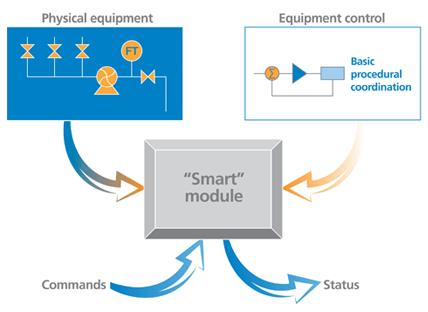 Equipment entities are formed by combining equipment control and physical equipment. They can accept commands and send out status.
Equipment entities are formed by combining equipment control and physical equipment. They can accept commands and send out status.
Modularization has been going on for decades, but the variety of equipment being handled this way is growing. The more manufacturers can do in a specialized environment with ideal tools and the most highly trained people, the easier it is to control costs and ensure the highest possible quality and safety. Process plants are embracing modularization in new ways and are gaining comfort with the practice.
Equipment delivered to the site in modules ready for installation can be dropped on a foundation designed to receive it, with piping and wiring in place and ready to connect. Modularization saves time because equipment can be built off site before all permits are received for a new facility. When final approval comes in, much of the equipment will be ready to install immediately, rather than having to wait to begin the construction process. Any module not too large to be shipped to the site can be built elsewhere and brought in as close to complete as possible. This can go as far as an entire plant or production unit.
Modularity beyond construction
The idea of modular equipment and construction is easy to understand, but ISA-88 is not really about equipment. However, it does go hand-in-glove with the modular movement by providing principles for design following the fundamental ISA-88 model: the physical model and the procedural control model (figure 1). ISA-88 offers guidelines to help build logical, internally consistent manufacturing systems by helping users understand concepts of modularity. Just as modular equipment is a way to save money, so is modular manufacturing.
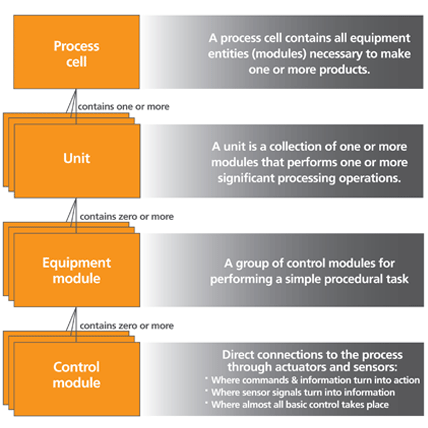 Figure 1. Understanding equipment structure is critical in an environment where hardware from a variety of sources has to work together seamlessly. In the 2010 update of ISA-88, the definition of a process cell was changed to allow it to directly contain either an equipment or control module, and a unit can directly contain a control module.
Figure 1. Understanding equipment structure is critical in an environment where hardware from a variety of sources has to work together seamlessly. In the 2010 update of ISA-88, the definition of a process cell was changed to allow it to directly contain either an equipment or control module, and a unit can directly contain a control module.
o understand modularity, consider the opposite approach. Old-fashioned batch manufacturing involves following a specific recipe using specific equipment. For example, to make 100 gallons of product X, begin by putting 50 gallons of feedstock 1 and 50 gallons of feedstock 2 into tank #100 and inject steam while agitating until the temperature reaches 160° F.
The recipe, procedures, and equipment are linked together and cannot be easily separated. This works very well if the company wants to make only product X in exactly the same way in the same amount with the same feedstocks using the same equipment indefinitely. But changes or deviations to add products or make alternate versions are complicated, because it is difficult to separate the various production elements from the final product.
ISA-88 helps users understand how the steps involved in making a product can be pulled apart and made into abstract modules (figure 2). One of the first steps is to separate the recipe from its equipment. The recipe simply describes what raw materials go into the final product and what has to happen to them in basic terms. A manufacturer can look at the recipe and determine if a given set of equipment or a process unit has the capability to perform those functions. For example, does tank #200 have a steam injector? An agitator? Is there any reason we cannot make product X using this process unit?
 Figure 2. Actual equipment has to be separated into different levels following the physical model definitions.
Figure 2. Actual equipment has to be separated into different levels following the physical model definitions.
Equipment needs to be thought of conceptually as modular, too, not just from a manufacturing standpoint, but also in terms of configuration and arrangement. With ISA-88, a process is considered in terms of modules, with dedicated control logic for each. Each module and its associated control code perform process tasks, but these are not product specific. A process cell can include multiple modular units. When equipment is modular, it can be set up to satisfy the requirements of numerous recipes or manufacturing campaigns by mixing and matching modules as required.
With modules, a recipe is product specific but not equipment specific. A recipe sets the order in which process modules should execute and how they should be linked to make the desired product, but operators can choose any equipment capable of fulfilling those specifications.
Along with equipment and recipes, control code and related automation infrastructure is separated into modules connected to the associated equipment (figure 3). If a vessel has a heating element module, the control code to regulate the heating element should be part of the module.
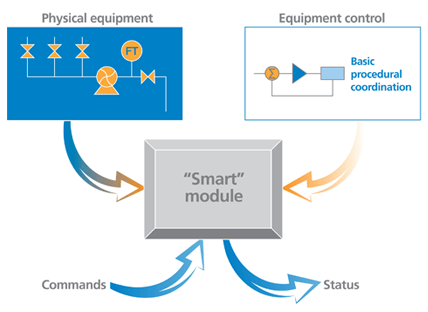 Figure 3. Equipment entities are formed by combining equipment control and physical equipment. They can accept commands and send out status.
Figure 3. Equipment entities are formed by combining equipment control and physical equipment. They can accept commands and send out status.
Do not forget the software
Software for control and procedure management can also be modularized, and ISA-88 makes critical contributions to realizing this objective by providing common batch control language and by defining models and terminology (figure 4). In fact, its original function was as an engineering tool to fill critical gaps for engineers trying to create structure for procedural control, process management, and interaction with the business level to make everything work efficiently and effectively.
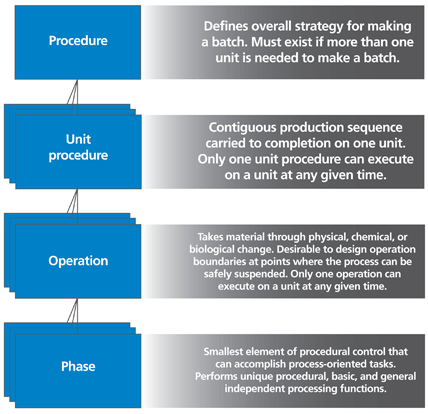 Figure 4. Just as equipment needs to be separated into its functional levels, so must procedures following common language and terminology.
Figure 4. Just as equipment needs to be separated into its functional levels, so must procedures following common language and terminology.
The standard has basic functions for addressing modularity issues:
- consistent terminology
- models to define tested structures
- abstraction to support manufacturing and provide design freedom
- standardization concepts for software producers
ISA-88 did not invent the concept of creating reusable control code, but it has mechanisms—language and organizational models—to make implementation far easier and more practical. Its structures allow engineers to define elements as simple as “stir” and “heat” along with more complex concepts, so code creators can structure programming by linking modular blocks of code, rather than by writing a monolithic program.
How much can modularity encompass?
Entire plants are being built today around modular concepts. Although there is still much to learn, there have been enough positive results to prove the concepts. ISA-88 has helped avoid many interoperability and plug-in issues common when multiple suppliers in different locations work on a single project.
The biggest constraints to modularization relate to physical shipping limitations. There are inescapable realities of tank and vessel sizes to support specific production levels. Anything unable to fit on a truck, railcar, or barge has to be fabricated on site, but for most plants, these turn out to be a very small number of items. Generally such size considerations only involve plants dedicated to refining or large volume petrochemical production, leaving the components of a typical food and beverage, pharmaceutical, or chemical manufacturing facility largely within the constraints of module shipping size.
Plant designs using module concepts can be scaled up or down and reconfigured or adjusted as needed to satisfy specific customer requirements. Modules that do not need to change can remain intact, so alterations only need to be made to specific modules, or to the manner in which these modules interact.
Extending the reach of ISA-88
As mentioned, over ISA-88’s 20-year life span, other standards have emerged by extending its basic concepts. Here are some examples of current ISA standard development work influenced by ISA-88.
ISA-101 on human-machine interfaces (HMIs), expected to be published by ISA in September 2015, considers how menu hierarchies, navigation, graphics, color use, and other dynamic elements can help tie together elements from a variety of suppliers to create a seamless interface for operators. Modularization on a large scale can be greatly simplified with this type of integration guidance. Additionally, ISA-88 affects development of HMI graphics to support a modular structure. The physical model determines how graphics are built and organized into a hierarchy.
ISA-106 on procedural automation for continuous processes draws from lessons learned using ISA-88 in batch applications over the years. Because procedures (e.g., startup, shutdown, grade change) used with continuous processes are much like batch processes, many of the same concepts apply and can be used to smooth over these critical transition periods when so many safety incidents and production interruptions occur.
The ISA-88 Part 5 standard currently in development defines a reference model for modular equipment control within equipment entities to address the control ascribed to equipment phases and equipment modules. The reference model applies to equipment that may be used in batch processes and on other types of production and packaging processes. It defines:
- a template for reusable modules and standard terminology
- a template for command and control functionality within and among modules
- a method to describe and identify each module
- a method for exchanging module definitions among interested parties
ISA-18.2 Technical Report 7 on alarm management for packaged systems (expected to be published by the end of 2015) looks at the practical side of incorporating modular equipment, such as prepackaged skids, into larger control system and alarm management strategies. The importance of this will grow as the variety of prepackaged and modular systems increases, and as they become more common in all types of plants. Using this standard involves defining different types of system architectures and defining how they are integrated into control systems. It also includes aspects of HMI integration including how alarm information is passed along and displayed for operators. Larger life-cycle management issues connected to alarms and other aspects of control integration are also being considered.
ISA-88 is still being applied in new environments, and there is more to be learned about the implementation of modular manufacturing in many forms. The standard has even entered into the world of discrete and continuous manufacturing, because many of the same concepts apply. ISA-88’s application has expanded over the years, and this will continue as manufacturing adopts more and more modularization.
About the Author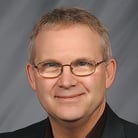 Marcus Tennant has been with Yokogawa Corporation since December 2008 as a senior principal technology specialist. Before Yokogawa, Tennant worked at Rockwell Automation for 10 years as a product manager and application engineer. Before that, he was with Morton International for 10 years, holding various positions in process development, project engineering, and quality assurance and with Jones-Blair Company for five years as a research and development chemist and process engineer. Tennant has a B.S. in chemical engineering from Michigan State University and an M.S. in operations and technology management from the Stuart School of Business at Illinois Institute of Technology. He has been a member of AIChE since 1984 and is also a member of ACS and ISA.
Marcus Tennant has been with Yokogawa Corporation since December 2008 as a senior principal technology specialist. Before Yokogawa, Tennant worked at Rockwell Automation for 10 years as a product manager and application engineer. Before that, he was with Morton International for 10 years, holding various positions in process development, project engineering, and quality assurance and with Jones-Blair Company for five years as a research and development chemist and process engineer. Tennant has a B.S. in chemical engineering from Michigan State University and an M.S. in operations and technology management from the Stuart School of Business at Illinois Institute of Technology. He has been a member of AIChE since 1984 and is also a member of ACS and ISA.
Connect with Marcus :![]()
A version of this article also was published at InTech magazine.
Click here to read this post by Marcus Tennant on modular systems at InTech magazine.



